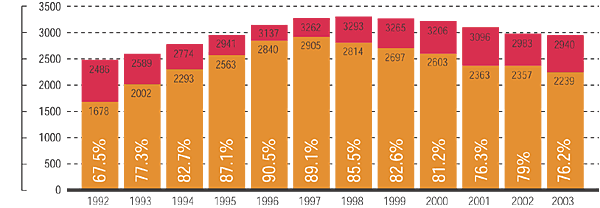
Fam Pract Manag. 2003;10(5):20-24
Supreme Court affirms “any willing provider” law
The Supreme Court unanimously ruled on April 2 that states can legally require HMOs and other insurers to accept into their networks any doctor, hospital or other provider willing to accept the insurer’s terms of service. The case centered on Kentucky’s any-willing-provider law, which had been challenged by the Kentucky Association of Health Plans. The association argued that Kentucky’s law violates the Employee Retirement Income Security Act (ERISA), which prohibits states from regulating employee benefits. Lawyers for the state of Kentucky countered that ERISA does allow states to regulate “insurance, banking or securities” and, therefore, that it does not prevent states from creating any-willing-provider laws. The Court agreed.
The effect of the ruling is unclear. Some argue that it will be negligible because not all states have any-willing-provider laws and because insurers will still be able to steer patients toward their preferred network of doctors by offering lower out-of-pocket costs to patients who choose those physicians.
However, health insurers say the ruling will result in higher health care costs. HMOs often negotiate lower reimbursement rates for physicians and other providers by promising them a large volume of patients. If HMOs have to broaden their networks and cannot provide high patient volumes, they say they will be forced to raise payment rates to physicians and other providers, which will increase the costs of health care services.
PRACTICE PEARLS from here and there
Going the extra mile
To really impress your patients, keep a pair of jumper cables in your office. “Several times a year we encounter a patient who has left his or her car lights on during the office visit, only to be greeted afterward by a car that won’t start. We now keep a pair of jumper cables in the office for just those occasions. Talk about grateful patients,” says Eugene Guazzo, MD, of Chaptico, Md.
For about $50, you can go one step further and purchase a portable jump-start power supply, says Tom Mason, MD, of Auburn, Ind. “It can be left plugged in at the office and takes up less space than jumper cables,” he says.
– Postings from the AAFP’s practice management listserv, February 21, 2003.
PRACTICE PEARLS from here and there
Get specific with your praise
Everyone appreciates recognition for a job well done; however, not everyone knows how to give praise effectively. For praise to have the most impact on your employees, it must be relevant and specific. The following openers will help to keep your praise on target:
“You really made a difference by …”
“I’m impressed with …”
“You’re doing great work on …”
“You can be proud of yourself for …”
“We couldn’t have done it without your …”
–Ten sentences that will help you retain your best employees. Conomikes Reports. February 2003:7.
Family practice match numbers continue to decline
The number of positions filled in family practice residency programs dropped in 2003 for the sixth consecutive year, according to preliminary data from the National Resident Matching Program (NRMP). The fill rate also dropped in 2003, after a slight increase last year. Of the 2,940 family practice positions offered this year, 76.2 percent were filled; 42 percent were filled by U.S. seniors. The other primary care specialties also experienced a decrease in filled positions.
To understand why residency fill rates are declining for family practice, the University of Arizona recently compared a number of variables for the 12 medical schools with the largest increase in graduates to family practice with the 12 medical schools with the largest decrease in graduates to family practice during 1998 to 2000. Results showed that medical students’ residency decisions are affected by a medical school culture that is negative toward family practice, a perception of low prestige of the specialty, interactions with dissatisfied family physician faculty and concerns about the breadth of knowledge required of family physicians. The AAFP believes medical school graduates are also selecting other specialties because they seem to offer more flexible lifestyles, greater financial incentives and fewer productivity pressures than family practice.

Doctors, hospitals try new response to medical errors
Covering up errors and denying allegations of wrongdoing may no longer be the health care community’s standard response to medical errors. Instead, physicians and hospitals are embarking on a “growing trend” of apologizing for and fully disclosing medical errors, reports the March 24 Los Angeles Times.
The Times cites a study published in the Dec. 21, 1999, Annals of Internal Medicine, which found that “extreme honesty may be the best policy.” The study looked at one Veterans Affairs Hospital, which has had a policy of full disclosure and fair compensation for medical errors since 1987, resulting in “encouragingly moderate liability payments.”
Leonard Marcus, director of the Program for Health Care Negotiation and Conflict Resolution at Harvard University’s School of Public Health, says in the Times that patients who have suffered from a medical error want three things: an explanation, an apology and an assurance that the mistake will not be repeated. Although a Feb. 26, 2003, JAMA study revealed that physicians are reluctant to provide this information, many health care organizations are creating systems to encourage greater openness. The Times reports that the VA has established a model approach that seeks not to assign blame but to identify what happened, why it happened and what can be done to prevent it from happening again.
Help with HIPAA
As health plans work to standardize electronic transactions mandated by the Health Insurance Portability and Accountability Act (HIPAA), there’s bound to be confusion. To facilitate communication between health plans and physicians and other providers during the process, the Council for Affordable Quality Healthcare and the Workgroup for Electronic Data Interchange have developed a helpful Web site (www.wedi.org/snip/caqhimptools). The site gives physicians and other providers up-to-date information about their health plans’ transaction changes and testing timelines. At press time, plans in 25 states had posted information on the site.
Managing long waits
If you thought open access and group visits were unconventional methods for managing long waiting times, consider this: In the orthopedics department at Boston’s Children’s Hospital, a customer service ambassador looks after patients in the waiting room and restaurant-type beepers alert patients when the doctor is ready to see them. In addition, the receptionists have been cross-trained to remove children’s casts so they can pitch in during especially busy times.
Trends in physician income
Between 1995 and 1999, when many professions in America enjoyed an increase in wages, the average physician net income dropped 5 percent, according to the Center for Studying Health System Change. In contrast, professional and technical workers’ incomes rose an average of 3.5 percent. Despite this drop, medicine continues to be one of the highest paid professions in the country, with a mean reported income for all patient-care physicians of $187,000.
Patients like HMOs?
HMOs are doing their job and doing it well, at least in Pennsylvania. According to the Pennsylvania Health Care Cost Containment Council, 86 percent of HMO members reported no problems with services provided by their HMO. The report emphasizes a correlation between higher preventive care rates in Pennsylvania HMOs and lower hospitalization rates. However, HMO members were more likely to experience certain surgical complications than those in fee-for-service plans.
Accepting new Medicare patients
The percentage of physicians willing to accept all new fee-for-service (FFS) Medicare patients dropped significantly from 76.4 percent in 1999 to 70.1 percent in 2002, according to a survey by the Medicare Payment Advisory Commission. The survey, which was intended to gauge the impact of last year’s 5.4-percent Medicare payment cut on physicians’ acceptance of new Medicare patients, found that while the majority of physicians continue to accept all new FFS Medicare patients, a growing percentage are either not accepting new Medicare patients or accepting new Medicare patients on a more selective basis.
Keep an eye on them

The managed care, health insurance and pharmaceutical industries would benefit from increased government regulation, says the public in an April 2 Harris Poll. Over 55 percent of those surveyed indicated that these industries should be regulated more carefully “for health, safety or environment reasons.” Less than 15 percent believed these industries were generally honest and trustworthy. Respondents favored more government regulation of the tobacco, life insurance and hospital industries as well.

Match-day lawsuit
As the 2003 match results are announced, a pending lawsuit brought by current and former residents alleges that teaching hospitals, medical associations and organizers of the National Resident Matching Program (NRMP) are violating antitrust laws by eliminating competition and sharing residents’ salary information, according to the March 21 Boston Globe. As a result of the lawsuit, changes are being made to residency programs, including limiting the numbers of hours a resident can work to 80 hours per week; however, there is no talk of abandoning the NRMP. Supporters of NRMP say that, without it, students would have to go back to the old system of applying directly to residency programs, which results in bidding wars and “unbelievable chaos.”
E-mail solutions

While many patients find e-mail an increasingly convenient way to communicate with their doctors, physicians remain concerned about liability, patient privacy and reimbursement issues. But their concerns are not insurmountable, according to the March 31 Los Angeles Times. Some patients and insurers have expressed a willingness to pay doctors for their e-mail communication, including Blue Shield of California Foundation, which will begin paying its doctors for online consultations this spring. To protect patient privacy, medical groups have subscribed to secure Web-based e-mail services, such as the AMA backed www.medem.com.